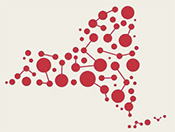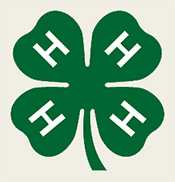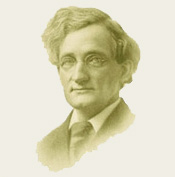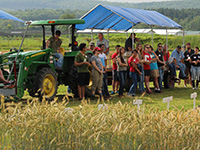Adapt these activities to the age, interest, and skill levels of your group.
Human Camera (pdf)
Time-Lapse Video(pdf)
Grass Photographs(pdf)
Connections to NYS Learning Standards
Activity: THE HUMAN CAMERA
Health, Physical Education, and Home Economics
STANDARD 2 Students acquire knowledge and ability necessary to maintain a healthy environment. Students develop skills of cooperation and collaboration. Students work constructively with others to accomplish a goal in a group activity.
STANDARD 3 Students understand and manage personal and community resources.
Mathematics, Science, and Technology
STANDARD 1 Students use mathematical analysis, scientific inquiry, and engineering design to pose questions and develop solutions.
STANDARD 2 Students access, generate, process, and transfer information using technologies.
STANDARD 3 Students understand math and become mathematically confident by communication and reasoning. Look at recurring patterns and functions.
STANDARD 4 Students understand and apply scientific concepts, principles, and theories. Students sharpen observation skills.
STANDARD 5 Students apply technological knowledge and skills to design, construct, use, and evaluate products. Students can describe how technology can have positive & negative effects on the environment — pollution, garbage, trash pickup.
STANDARD 6 Students understand and apply relationships and common themes that connect math, science, and technology. Students observe and describe interaction among components of simple systems and identify common things that can be considered to be systems (e.g., a plant population). Students analyze data and look for patterns.
STANDARD 7 Students apply knowledge and skills of math, science, and technology to address problems.
English Language Arts
STANDARD 1 Students listen, speak, read, and write for information and understanding. Students collect data, facts, and ideas, discovering relationships, concepts, and generalizations, and using knowledge from oral, written, and electronic sources. Online resources.
STANDARD 2 Students will read, write, listen, and speak for literary response and expression. Write haiku about observed plants.
STANDARD 3 Students listen, speak, read, and write for critical analysis and evaluation.
STANDARD 4 Students listen, speak, read, and write for social interaction. Discuss observations, share poetry.
The Arts
STANDARD 2 Students make use of materials and resources for participation in the arts. Artwork could be featured in a nature based poetry slam.
STANDARD 3 Students will analyze visual characteristics of the natural environment and explain social, cultural, psychological, and environmental dimensions of the visual arts. Students respond critically to variety of works in the arts.
STANDARD 4 Students understand personal and cultural forces that shape artistic communications. Students explore concept of art made with nature.
Activity: TIME-LAPSE VIDEO
Health, Physical Education, and Home Economics
STANDARD 2 Students develop skills of cooperation and collaboration. Students work constructively with others to accomplish a goal in a group activity.
STANDARD 3 Students understand and manage personal and community resources.
Mathematics, Science, and Technology
STANDARD 1 Students use mathematical analysis, scientific inquiry, and engineering design to pose questions and develop solutions.
STANDARD 2 Students access, generate, process, and transfer information using technologies.
STANDARD 3 Students understand math and become mathematically confident by communication and reasoning. Measurement and estimation skills, time line, look at recurring patterns/functions.
STANDARD 4 Students understand and apply scientific concepts, principles, and theories.
STANDARD 5 Students apply technological knowledge and skills to design, construct, use, and evaluate products. Students as a group plan and implement a school project. Design & model time-lapse video.
STANDARD 6 Students understand and apply relationships and common themes that connect math, science, and technology. Students observe and describe interaction among components of simple systems and identify common things that can be considered to be systems (e.g., a plant population).
STANDARD 7 Students apply knowledge and skills of math, science, and technology to address problems.
English Language Arts
STANDARD 1 Students listen, speak, read, and write for information and understanding. Students collect data, facts, and ideas, discovering relationships, concepts, and generalizations, and using knowledge from oral, written, and electronic sources. Online resources.
STANDARD 2 Students will read, write, listen, and speak for literary response and expression.
Printed flip book.
STANDARD 4 Students listen, speak, read, and write for social interaction. Screen video.
The Arts
STANDARD 1 Students will actively engage in processes that constitute creation and performance.
STANDARD 2 Students make use of materials and resources for participation in the arts.
STANDARD 3 Students will analyze visual characteristics of the natural environment and explain social, cultural, psychological, and environmental dimensions of the visual arts. Students respond critically to variety of works in the arts in the production of film.
STANDARD 4 Students understand personal and cultural forces that shape artistic communications. Students explore concept of art made with nature.
Activity: GRASS PHOTOGRAPHS
Health, Physical Education, and Home Economics
STANDARD 2 Students develop skills of cooperation and collaboration. Students work constructively with others to accomplish a goal in a group activity.
STANDARD 3 Students understand and manage personal and community resources.
Mathematics, Science, and Technology
STANDARD 1 Students use mathematical analysis, scientific inquiry, and engineering design to pose questions and develop solutions.
STANDARD 2 Students access, generate, process, and transfer information using technologies.
STANDARD 3 Students understand math and become mathematically confident by communication and reasoning. Predict experimental probabilities. Measure growth of plants.
STANDARD 4 Students understand and apply scientific concepts, principles, and theories.
STANDARD 5 Students apply technological knowledge and skills to design, construct, use, and evaluate products. Students as a group plan and implement a school project.
STANDARD 6 Students understand and apply relationships and common themes that connect math, science, and technology. Students observe and describe interaction among components of simple systems and identify common things that can be considered to be systems (e.g., a plant population).
STANDARD 7 Students apply knowledge and skills of math, science, and technology to address problems.
English Language Arts
STANDARD 1 Students listen, speak, read, and write for information and understanding. Students collect data, facts, and ideas, discovering relationships, concepts, and generalizations, and using knowledge from oral, written, and electronic sources. Online resources.
STANDARD 4 Students listen, speak, read, and write for social interaction. Screen photographic print on living canvas.
The Arts
STANDARD 1 Students will actively engage in processes that constitute creation and performance.
STANDARD 2 Students make use of materials and resources for participation in the arts.
STANDARD 3 Students will analyze visual characteristics of the natural environment and explain social, cultural, psychological, and environmental dimensions of the visual arts. Students respond critically to variety of works in the production of grass art installations. They will use concepts from other disciplines to enhance their understanding of photography.
STANDARD 4 Students understand personal and cultural forces that shape artistic communications. Students explore concept of art made with nature.
top









